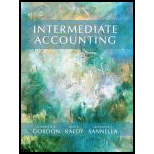
a.
The classification of lease.
Given information:
Lease term is 4 years.
Economic life of asset is 4 years.
Fair value of the asset is $232,511.
Carrying value of asset is $200,000.
Interest rate is 8%
Annual lease payments are $65,000 due on Jan/1 each year
b.
To prepare: The amortization tables for the lease term.
Given information:
Lease term is 4 years.
Economic life of asset is 4 years.
Fair value of the asset is $232,511.
Carrying value of asset is $200,000.
Interest rate is 8%
Annual lease payments are $65,000 due on January 1 each year
c.
To prepare: The journal entries of sales type lease for lessor for year one.
Given information:
Lease term is 4 years.
Economic life of asset is 4 years.
Fair value of the asset is $232,511.
Carrying value of asset is $200,000.
Interest rate is 8%
Annual lease payments are $65,000 due on Jan/1 each year
d.
To prepare: The journal entries for the lessee for year one.
Given information:
Lease term is 4 years.
Economic life of asset is 4 years.
Fair value of the asset is $232,511.
Carrying value of asset is $200,000.
Interest rate is 8%
Annual lease payments are $65,000 due on Jan/1 each year
Want to see the full answer?
Check out a sample textbook solution
Chapter 18 Solutions
Intermediate Accounting
- Brookfield Technologies provides the following Financial informationarrow_forwardHarbor Groceries began the current month with inventory costing $28,750, then purchased inventory at a cost of $70,560. The perpetual inventory system indicates that inventory costing $76,400 was sold during the month for $81,300. If an inventory count shows that inventory costing $21,600 is actually on hand at month-end, what amount of shrinkage occurred during the month?arrow_forwardanswer??arrow_forward
- Tutor give me answerarrow_forwardSolve with explanation and accounting questionarrow_forwardRoyal Catering began the year 2019 with $3,000 of supplies on hand. During the year, they purchased $40,000 of supplies with cash. On December 31, 2019, they had $5,000 of supplies remaining. What entry will they report to record the supplies used for the year? A. Debit Supplies Expense and credit Supplies for $35,000. B. Debit Supplies Expense and credit Supplies for $40,000. C. None of these answers are correct. D. Debit Supplies Expense and credit Supplies for $38,000. E. Debit Supplies Expense and credit Supplies for $32,000.arrow_forward

 AccountingAccountingISBN:9781337272094Author:WARREN, Carl S., Reeve, James M., Duchac, Jonathan E.Publisher:Cengage Learning,
AccountingAccountingISBN:9781337272094Author:WARREN, Carl S., Reeve, James M., Duchac, Jonathan E.Publisher:Cengage Learning, Accounting Information SystemsAccountingISBN:9781337619202Author:Hall, James A.Publisher:Cengage Learning,
Accounting Information SystemsAccountingISBN:9781337619202Author:Hall, James A.Publisher:Cengage Learning, Horngren's Cost Accounting: A Managerial Emphasis...AccountingISBN:9780134475585Author:Srikant M. Datar, Madhav V. RajanPublisher:PEARSON
Horngren's Cost Accounting: A Managerial Emphasis...AccountingISBN:9780134475585Author:Srikant M. Datar, Madhav V. RajanPublisher:PEARSON Intermediate AccountingAccountingISBN:9781259722660Author:J. David Spiceland, Mark W. Nelson, Wayne M ThomasPublisher:McGraw-Hill Education
Intermediate AccountingAccountingISBN:9781259722660Author:J. David Spiceland, Mark W. Nelson, Wayne M ThomasPublisher:McGraw-Hill Education Financial and Managerial AccountingAccountingISBN:9781259726705Author:John J Wild, Ken W. Shaw, Barbara Chiappetta Fundamental Accounting PrinciplesPublisher:McGraw-Hill Education
Financial and Managerial AccountingAccountingISBN:9781259726705Author:John J Wild, Ken W. Shaw, Barbara Chiappetta Fundamental Accounting PrinciplesPublisher:McGraw-Hill Education





